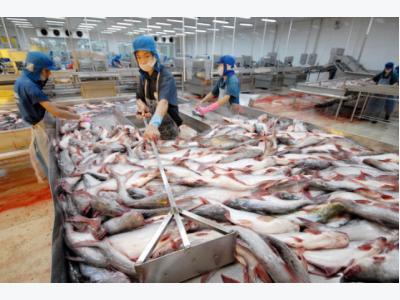Pangasius hypophthalmus fish exports to China: big opportunity but many risks

According to the Vietnam Association of Seafood Exporters and Producers (VASEP), the sudden increase of Pangasius hypophthalmus fish exports to China market is not only a big opportunity but has also many risks for enterprises.
Pangasius hypophthalmus processed for export
According to VASEP, in January, 2017, while the pangasius hypophthalmus exports to the US sharply fell by 40.9%, to the EU fell by 22.2% over the same period last year but pangasius hypophthalmus exports to the second largest single market of Vietnam which is China - Hong Kong still reached $US 17.7 million, up by 3.5% over the same period in 2016.
In the recent five years, the growth of pangasius hypophthalmus exports to China increased from 24.2 % to 88.7% annually. In particular, the total export value of pangasius hypophthalmus to China market in 2016 reached $US 304.7 million, up by 4.17 times over the previous five years (2012) and almost doubled compared to the previous year (2015). Only in two years from 2015 to 2016, the export value of pangasius hypophthalmus to the China market increased nearly 2 times.
As reflected by many enterprises, the demand for pangasius hypophthalmus for domestic consumption in restaurants, hotels, school meals, and companies of China - Hong Kong increased sharply. Chinese people also processed 600 different dishes from Vietnam pangasius hypophthalmus.
In the past 10 years, demand for seafood imports from China increased sharply, in which, shrimp and pangasius hypophthalmus were the two products with the highest import value from Vietnam. However, in recent years, the growth of pangasius hypophthalmus imports in this market increased very fast, and has gradually become favorite dishes besides other seafood, whitefish and even competes with Chinese tilapia.
In 2016, pangasius hypophthalmus exports to most large markets faced many difficulties. Although exports to the US market still reached $US 387.4 million, up by 22.8% over the same period last year, the number of enterprises exporting pangasius hypophthalmus to this market is not more than 4 enterprises due to the high anti-dumping duty and severe technical barriers of the Catfish Inspection Program.
Pangasius hypophthalmus export markets with good export price level were: ASEAN also up by 0.2%, Mexico down by 12%, Brazil down by 12.5%, Colombia down by 5.4% and Saudi Arabia down by 16.6 % over the previous year. Therefore, China was considered as a potential market for pangasius hypophthalmus exports in 2016 and possibly in the next few years.
According to some export enterprises, pangasius hypophthalmus exports to the China market were very potential and had many opportunities. Sometimes, the export price of pangasius hypophthalmus to China was higher than that of the EU.
However, many enterprises said that selling pangasius hypophthalmus to some Chinese enterprises means taking risks, including the risk of payment. One enterprise said that many Chinese enterprises normally asked for a deposit of only 30% of the total value of the consignment plus with an average transport price of the fish at the border gate of about 45 - 47 million vnd. When the container comes to the gate, if the Chinese enterprises receive the goods, the transaction is successful, and if they do not receive the goods, the enterprises take a loss.
At present, most pangasius hypophthalmus products exported to the China market are in 2 main forms: Pangasius hypophthalmus butterfly and Pangasius hypophthalmus fillets. Some enterprises noted that for the butterfly product, if the Chinese enterprises buy, it is good due to good prices and large volume, but if they do not buy, it is really difficult to export to any markets.
The payment for pangasius hypophthalmus orders to China is quite diversified, customers can pay in USD, RMB or even VND. However, most customers request payment in RMB or VND, while most Vietnamese export enterprises expect to be paid in USD. In the context where the Chinese importers increase the imports through both official trade and unregulated trade of seafood, the competent authorities of the two countries also issued agreements on quality control of export seafood.
Accordingly, the National Agro-Forestry-Fisheries Quality Assurance Department (NAFIQAD) is the agency which grants certificates for export consignments. However, in practice, cross border trade has loopholes, many Chinese still buy goods without certificates for consignments through unregulated trade.
Some enterprises said that to avoid the lessons that happened to tea in the past few years in the Taiwan market, currently, some foreign enterprises are hiring factories or processing Vietnam pangasius hypophthalmus and then transporting them by road to sell in China through unregulated trade without being controlled. This may affect the quality of seafood exports and be unfair for export enterprises.
As identified by the VASEP, It is clear that the huge consumption in the China market is opening up opportunities for pangasius hypophthalmus export enterprises and makes up for shortages in other markets. But in addition to this sudden growth, enterprises also need to pay attention to some cases of risk and promote or maintain the quality of pangasius hypophthalmus exported to China - Hong Kong markets to avoid the risks which occurred for tea export enterprises
Có thể bạn quan tâm
 Nearly VND165 billion for fisheries restructuring in 2017-2020
Nearly VND165 billion for fisheries restructuring in 2017-2020 As many as VND164.8 billion (US$7.16 million) will be earmarked for technology transfer serving the restructuring of the fisheries sector during 2017-2020
 Challenges ahead for King of pangasius
Challenges ahead for King of pangasius after the audit of the company’s financial reports showed a big discrepancy between the audited and self-reported profit, revenue, and liabilities.
 Action plan drafted to develop shrimp sector
Action plan drafted to develop shrimp sector The Ministry of Agriculture and Rural Development is collecting opinions to finalise a national action plan for shrimp development through 2025.